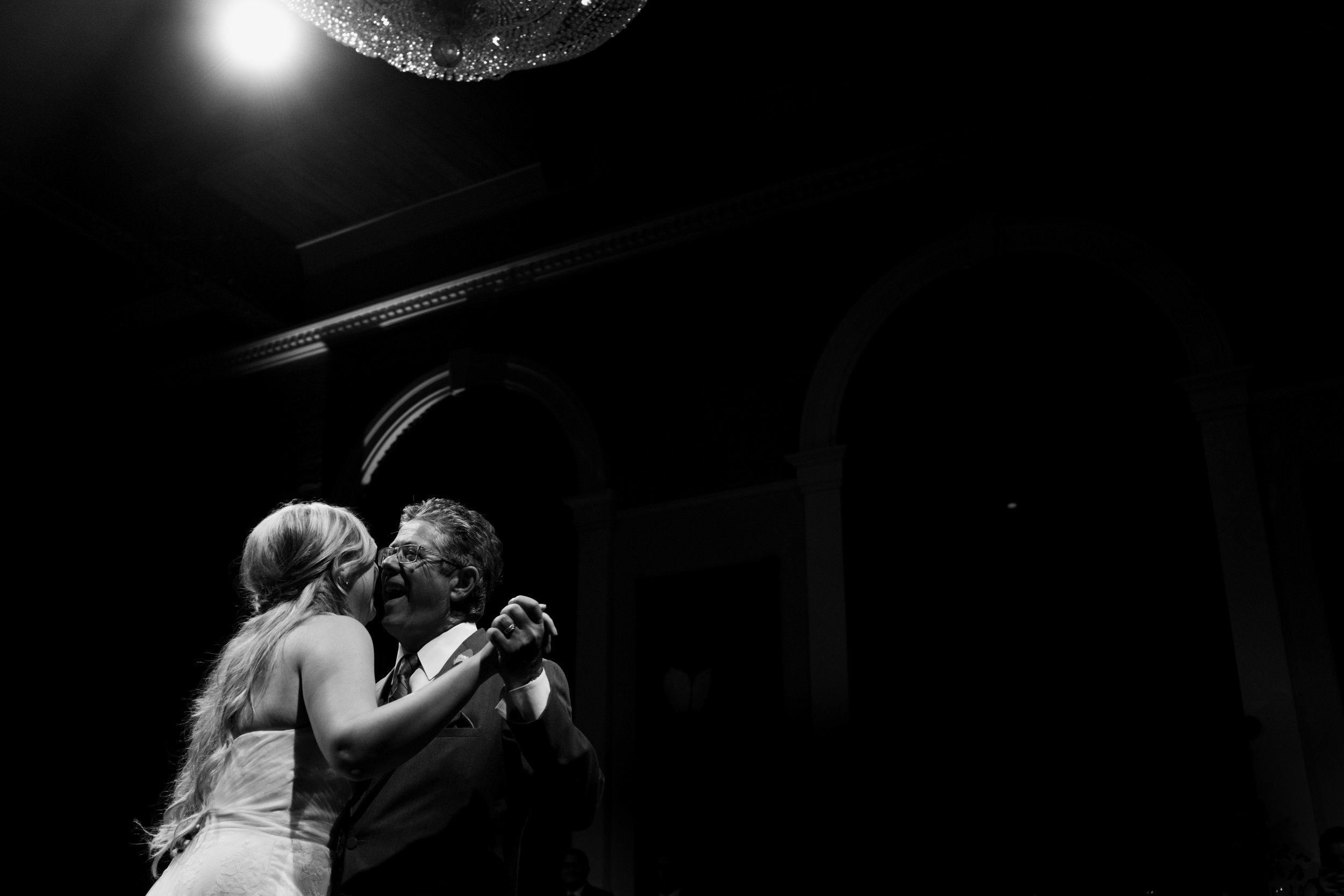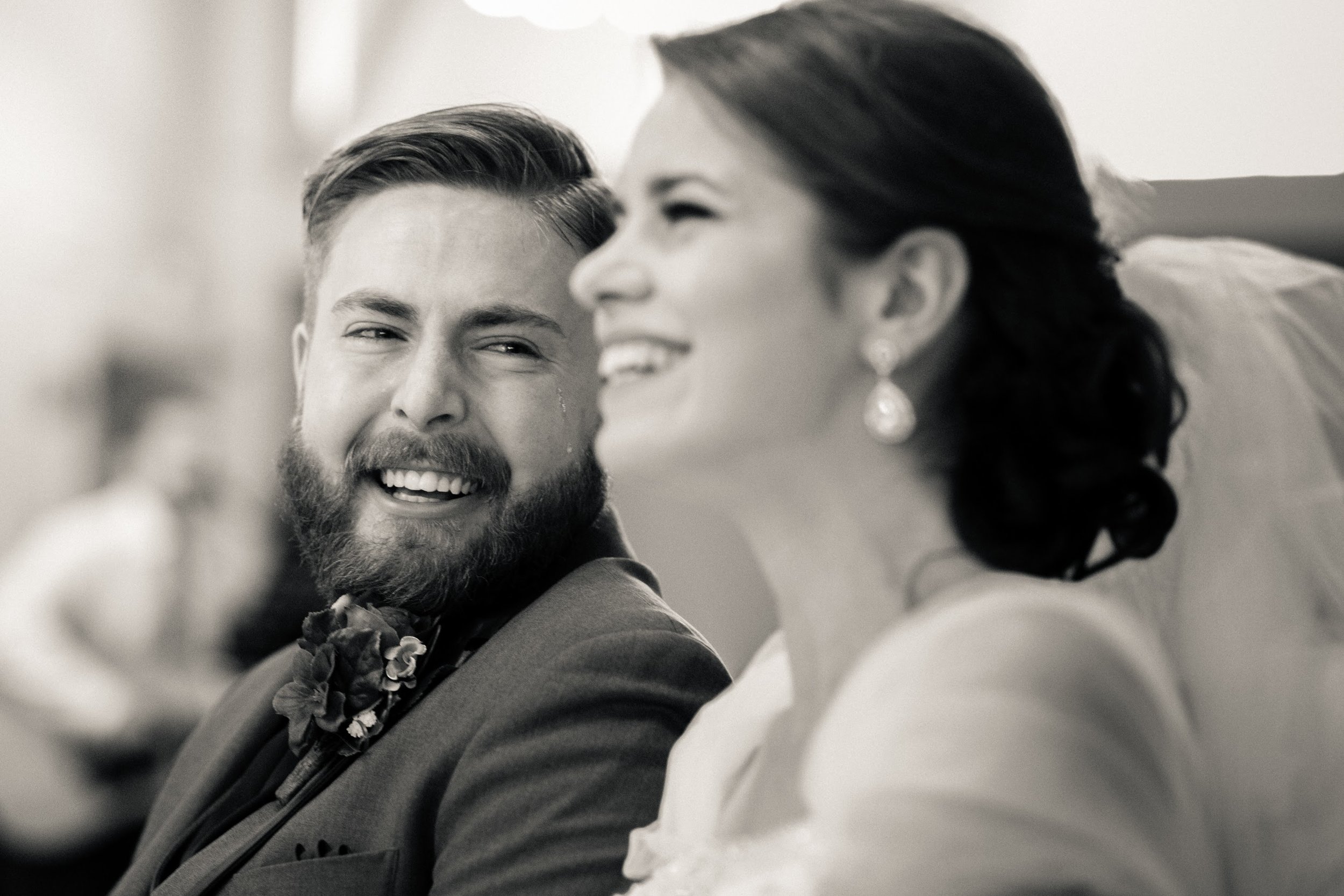Manual focusing for wedding photography
It’s 2017, we are constantly bombarded by new cameras, it seems like every few weeks a new one is released. One would naturally expect that professional photographers are using the latest and greatest tech, lenses so big and heavy you can use them for self defence, and cameras that take so many photos per second you might as well be shooting a video. Well, that’s not how I do things when it comes to wedding photography. The images I'll be showing in this post were selected to show situations where my techniques work particularly well.
The subjects were off center, the background is very dark, and they were moving around. It was difficult to get the focus right, while exposing for the subjects and compose all at the same time.
This photo is a good example of why the EVF is so good for situations like this. The camera would have vastly underexposed this photo given how bright the side of the car was. One way around this would be to use spot metering, expose for the dad's face, recompose and then shoot, but the expression would have been gone. Another way would be to link spot metering with a selected focusing spot, but that would require you to select the focusing point first, and again that would have taken too long and the expression would be gone.
My unconventional, and some might even consider archaic techniques goes completely against conventional wisdom (at least modern conventional wisdom since the dawn of digital cameras). I like small cameras for their nimbleness and light weight, I use manual focus for the majority of the day (big shocker, I know), and my most used lens is from the 1980s (my trusty Canon nFd 50mm f1.4). A lot of wedding photographers would call me a mad man for doing this to myself, but to me, this is the only way that works for me.
I did not anticipate the mom to walk into the scene, for a split second, she brushed her face as if wiping away a tear. There was no time to mess about with focusing points, or recompose after focusing. I manually focused while adjusting the exposure compensation, other wise the image would have been thrown off by the bright window.
The bride and her mother were checking to see if there is anything on their teeth (probably). I raised the camera up while instinctively start turning the focusing ring, so by the time its at eye level the focus was pretty close to perfect, theres no need to recompose, and the moment was captured perfectly.
This all started when I was just getting into wedding photography, trying to find my own style so that my work can stand out from so many other amazing photographers. I have always been drawn to the photojournalistic work from the early to mid 1900s, by Henri Cartier-Bresson, Robert Frank, Eugene Smith, just to name a few. Their ability to capture a scene with such perfect composition and timing was astonishing, and it was all done with old manual focus film cameras. I like to think of weddings as the perfect occasion to document using this style of photography. The day is all about the couple, the family and friends, it’s about happiness, and the union of two people who are completely in love. It isn’t about the photographer, it’s not about being in everyone’s face just to get a shot, but end up ruining a beautiful natural moment. This means I have to work very fast, while trying to be as unobtrusive as possible. (Disclaimer: this is the technique that works for me, it’s not for everyone, and I certainly do not advocate that everyone must work the same way.)
I was walking through the crowd as the guests were mingling with the newly weds. I wanted to capture this intimate interaction without being noticed, or else they will act unnatural. This photo would have been possible by using the center focusing point with a DSLR, but the subjects would be dead center, which makes for a boring composition.
The rise of mirrorless cameras couldn’t have been more perfectly timed, it happened right around the time I started shooting weddings. Now, there are countless blog posts and articles comparing the differences between conventional DSLRs and mirrorless cameras, but for me, the EVF on mirrorless cameras is the one feature that changed everything. Let me explain, having an EVF means WYSIWYG (what you see is what you get), you get to see the exact exposure of your image before the photo is taken. I no longer need to "chimp" at the lcd screen to make sure I got the focus and exposure correct. This is especially useful for scenes with extreme contrast, such as when shooting into a car in the mid day sun, or shooting the bride as she walks through the doors of a dark church. I get the right exposure every single time. As good as DSLRs are at metering a scene, you can’t help but review the images just to make sure you got the shot, and that’s time you could have been using to look for interesting things to photograph.
A fast paced interaction after a speech, the father and the groom were shaking hands while the mother and the bride were exchanging a quick word. Obviously the focus was on the girls here, and I had to shoot through the boys while not getting fooled by the bright curtains in the background.
A very difficult situation for exposure and focusing. The couple were moving constantly and in changing light, I compensated the exposure for the upper left corner of her face while focusing at the same time, without having to recompose.
The other advantage with mirrorless is the short flange distance, meaning they can be mounted with almost every lens with an adapter. The 30 year old manual focus lens from my film camera is suddenly resurrected, the sensation of a buttery smooth focusing ring is nothing short of magical, it’s simply a piece of well engineered equipment designed to last. With the focus peaking feature in the EVF and adapted manual focus lenses, I was able to capture scenes in a completely different manor. I no longer needed to rely on autofocus, and thus avoided some of the most dreaded problems with autofocus, such as having to focus and recompose, focusing through objects, or having to select specific focus points before taking the shot. I can pick up the camera, focus, adjust the exposure if required and take the shot all in one continuous motion. This way I don’t need to worry about recomposing a scene that only lasts for a split second and miss the shot. I’m not saying that this is impossible to do with DSLRs, it certainly can be done especially if you are good at anticipating a scene, just check out Jeff Ascough’s work. Jeff is one of my biggest inspirations, and one of the most successful documentary wedding photographers working today. The mirrorless workflow with manual focus lenses just feels more natural to me, so that’s what i’m sticking with. I should mention that I am by no means the first person to use this technique, check out Joao Medeiros, his work is pure magic.
Another split second moment that had to be captured off center, and very quickly to capture the expressions and include the bride in the frame.
I wanted to capture a silhouette of the mother putting on perfume, the EVF allowed me to set the exposure correctly right away, instead of having to check and re-shoot.
The guys dance in a circle while i try to squeeze in for a shot. This is pushing the limits of the camera, and underexposure would have made the photo unusable.
The camera that sees the most action is a Sony A7 mounted with a Canon nFd 50mm f1.4 about 95% of the time, I also have a Canon Fd 28mm f2.8 for a wider field of view. This combo is what I reach for most of the day, the rest of the time is split between Fuji X-100T and Canon 6D (I know, kind of ironic after this long blog post about how great mirrorless cameras are, I’m working on finding a replacement). Oh, and I also shoot medium format film on a Mamiya 645e, but that’s a whole other can of worms, and worthy of it’s own post.









